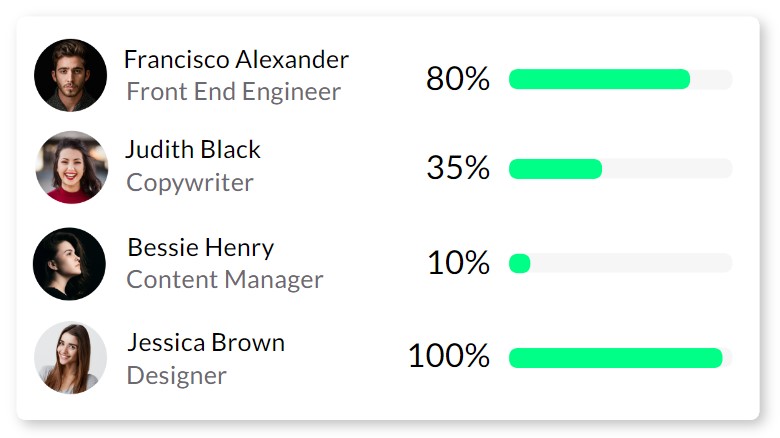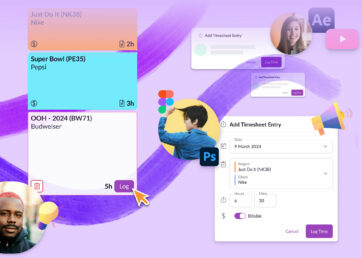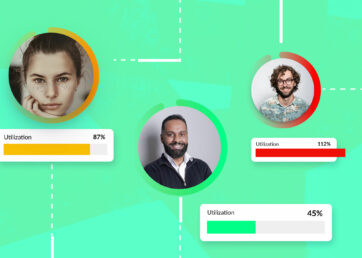Agency culture has an infamous reputation. Agencies are known for producing creative work that can shape the perspectives of an entire generation, while at the same time being completely oblivious to the concept of agency work-life balance.
But there’s change on the horizon. A push for transforming how, when, and where they work (along with the tools they use).
Could it be? Are agencies finally getting the cultural makeover they don’t just deserve, but so desperately need?
It’s not easy to change organizational culture, but making a conscious effort to change is where it all begins.
In this article 📖
Agency culture definition
If you’re wondering what agency culture means, you’re in the right place.
Agency culture (good or bad) is a direct result of your values, processes, and how you treat your employees. It’s what sets the tone for how your team feels and behaves at work. All of which will immediately impact how well your business performs.
Why creating a healthy agency culture is so important
A poor (or even toxic) work culture won’t just negatively affect your team’s life outside of work, it will also spill over into client relationships. Worst case scenario? You’ll end up losing clients, leaving a lasting impact on your business.
You can’t really talk about agency culture without mentioning the “Father of Advertising,” David Ogilvy. He had strong views on agency culture, and even back in the 1950s, his #1 value was “We treat our people like human beings.”
Safe to say, things have taken a turn since then. So how can we get back on track?
7 ways to create a strong agency culture (starting from scratch)
We go beyond ping pong and pizza parties in the breakroom, with seven meaningful ways to consciously create an agency culture people can actually get behind.
That starts with the right values.
1. Choose your core agency values wisely
The values you choose—or an absence of values—sets the tone for your agency. That’s because they act as a guide for day-to-day life in your company.
With the right values in place, your senior leadership knows how to lead with those values top of mind. The same goes for the wider team. When values are clear, employees understand what traits they should embody at work.
That gives your team (leadership or otherwise) the tools to make decisions that align with your values, creating autonomy. Team autonomy reduces decision-making time and the risk of errors. That provides space to keep projects on track and on budget.
Examples of values within an agency setting:
- Teamwork. Collaboration is baked into the cake. We understand that we’re stronger together, and we’re happy to lend a helping hand to a teammate, even from a different department.
- Transparency. Effective working relationships rely on trust. Transparency builds trust. So we are transparent with our teammates, leadership, and other departments about our successes and areas for improvement.
- Growth. We look for ways to grow together that align with our core values, the team’s needs, and broader business goals.
2. Embed your agency values into everything
Here’s the thing: Adding your values to a poster and hanging it up for passive consumption isn’t enough. You need to build them into everything from the ground up.
It’s about practicing your values, not preaching.
Here are three ways you can do that:
- Your hiring practices. One bad apple spoils the bunch. Represent your values within interview questions so you can hire a company-value match from the word go. This especially applies when hiring for leadership positions. Your leaders should lead by example, and that means embodying your values.
- The clients you onboard. Clients that don’t align with your company values (and the values of the team you hired) can create headaches. The value mismatch won’t just be frustrating for your teams, but it might impact performance, and eventually, your agency’s bottom line.
- Your marketing. If you want to onboard the right team and clients, first, you need to attract them. Use your marketing efforts to sing about your values in a way that resonates with people who share them.
3. Build robust processes
Building robust processes early on is a value-producing activity. They create efficiencies (i.e., opportunities to increase or recoup lost revenue) and foster work-life balance.
More often than not, processes give your agency team a tried and tested framework to follow. That framework can help them get their workload done in a manageable way. That means fewer late nights, working lunches, and weekend shifts to get projects over the line.
Better work-life balance mitigates the risk of agency burnout and gives your organization a culture worth striving for.
Agency processes can include:
- Agency workflows. A birds-eye view of how to get from A to B for projects and operations.
- Agency standard operating procedures (SOPS). What would a birds-eye be without getting granular? SOPs are detailed step-by-step processes, tasks, or activities from the broader workflow.
- Agency resource management and planning. Align the right people with available work across projects, and boost agency team well-being and billable hours.
Let your values guide your processes, not the other way around.

A Strategy Director in advertising sharing their thoughts on Fishbowl.
4. Create a culture of recognition
When good work goes unnoticed, it can turn your agency into a breeding ground for resentment. Then, if recognition and rewards are inconsistent (i.e., some leaders reward their team, others don’t), that resentment magnifies.
On the other hand, when you appreciate your agency team for their achievements, they feel valued. Valued employees are happier, more productive, and tend to be more dedicated to their company.
Ways to create a culture of recognition can include:
- Slack or more informal meetings. These create space for more casual ways for teammates to celebrate each other’s great work. How about a dedicated #celebrations channel? Remember, celebrating small wins can go a long way.
- A formal recognition program. You could bake this into your weekly or monthly team updates or do something else entirely. Either way, every leader knows to recognize their team’s hard work, creating a consistent culture of recognition across your agency.
- Encourage recognition from outside of leadership. It doesn’t have to be leadership or project leaders recognizing good work. Encourage your entire agency to recognize and celebrate a job well done.
5. Set realistic goals and timelines
If you don’t root your project goals and timelines in reality, you’re setting your team up for failure and disappointment. Here’s another kicker: by painting beautiful pictures of painfully unrealistic project expectations, you’re setting clients up for disappointment too.
Low employee and client satisfaction = High employee and client churn.
If a strong agency culture and healthy profit margin were a balloon, that equation is the sharp pin that pops it. The trick? Set realistic goals and timelines that see you hitting deadlines without compromising your agency culture or the quality of client work.
Here’s how to set realistic goals and timelines:
- Factor the effort vs. scope. Make sure you have the right people in the room when you’re working out the project scope. That way, you know how much work is really required to get from A to B.
- Align your expectations with team availability. You’ve laid out your grand vision, aka your project roadmap. It’s a work of art, truly. But, two of the copywriters you need are booked for the next six months, delaying your dream timeline. The lesson? Check your team availability before you set project expectations.
- Set regular check-ins. That way, you can reassess workloads against project needs throughout the project life cycle.
6. Set boundaries with clients (and stick to them)
A boundaryless client-agency relationship leaves your team open to burning the candle at both ends to meet deadlines and finish projects. That’s a fast track to zero agency work-life balance and, as a result, poor company culture.
So first, you need to set clear boundaries and expectations with your clients. Then, you need to try your hardest to stick to them.
Client boundaries may include:
- Communication. Let your client know communication expectations from the start. That includes where, when, and how often communication happens. Plus, who to contact about the project, who will typically attend meetings, and who to reach out of hours.
- Timelines. Set a realistic timeline that accounts for skills and available resources and leaves a buffer for bottlenecks. Of course, you need to be flexible here. But if you need to bring a milestone forward, re-allocate workload where required so you don’t overburden your team to make it happen.
- Payment. As an agency, you’re responsible for employee wages. But if clients don’t pay you, how can you pay your team? So lay out your client payment terms (i.e., how much, when, for what scope, and your late payment terms) in the contract. Then go through them with the client and answer any questions. But don’t start work until the contract is signed.
7. Create psychological safety (by putting your team first)
Psychological safety means your employees can share feedback, ask questions, own their mistakes, and raise concerns. And they feel safe enough to do so because agency leadership won’t punish or humiliate them.
Research shows that teams with higher degrees of psychological safety show increased performance. There’s also less interpersonal conflict. But if your team doesn’t feel psychologically safe, it can be a glaring sign of poor agency culture.
One way to create psychological safety is to put your team first. Here’s how:
- Avoid sales for the sake of sales. To make a profit (and survive as an agency), you must keep your client roster and pipeline full. So it can be tempting to reach for any old sale just for the sake of a sale. But onboarding the wrong type of client will create demoralizing work that demotivates your team.
- Encourage your team to set work-life boundaries. Remind them to take all their annual leave, take regular breaks, and not skip lunch. And when they’re off, encourage them to really switch off from work—no Slack, no emails, no calls. Period.
Employee assistance programs (EAPs) and wellness programs. Offering free mental health resources, health app subscriptions, or mindfulness classes are examples of these programs. But if you’re introducing programs from scratch, get feedback from your team about what they’d prefer.
Resource management’s role in agency culture
Planning, scheduling, and allocating your team’s time (resource management) can make or break your agency’s culture.
Get it right, and you plan balanced workloads, reduce friction between teams, and promote teamwork across your agency. You get it wrong and look at overburdened teams, frayed interpersonal relationships, and poor collaboration.
Let’s take a look at three resource management areas to consider.
1. Capacity planning
Capacity planning is the art of balancing available resources against project needs. In an agency setting, this gets trickier because you’ll be balancing multiple client projects at once. If you commit to setting realistic project goals and timelines from the get-go? You’re halfway to better agency capacity planning.
Aside from that, be mindful of your team utilization rate—70-80% is the sweet spot. That will help keep your team happy, healthy, and productive. It also reduces the risk of project failure because of overburdened resources.
2. Workload planning
Workload planning is how you plan, prioritize, and share work among your team. The aim is to create manageable workloads that protect team well-being and increase productivity. And avoid setting unreasonable workloads that overburden in-demand team members or the team at large.
Robust capacity planning and keeping that 70-80% utilization rate will help you plan balanced workloads.
You can also follow the 80/20 rule. That means you should only schedule up to 80% of someone’s time on intense work. You keep the other 20% back for admin, downtime, and as a buffer for urgent issues.
3. Clash management
Clash management prevents overbookings, double-bookings, or other scheduling conflicts that create team disharmony.
When it comes to clash management, half of the battle is schedule visibility. Without schedule visibility (including at the leadership level), you lack transparency between teams and departments.
That means you’re always one booking away from stepping on an already overburdened teammate’s toes. You also risk micromanaging people because you can’t see their schedule. And nothing creates team friction like micromanaging.
So, if you care about your agency culture, consider a clash management solution with a single schedule.
You might also want to find a tool that has a booking approval workflow to protect in-demand people. Plus, as you’re scaling your agency, it will become harder to keep track of who’s available, who’s not, and who’s booking who.
You can introduce something manually or by using a spreadsheet. But it’s much faster and easier to scale your clash management process using agency resource management software. Look for a tool with a single schedule, clash warnings, and capacity/utilization rates in one place.
How to boost your existing agency culture
Here’s how to improve agency culture when you’ve been up and running for a while.
- Shift your mindset. Historically working at an agency meant burning the candle at both ends. That can lead to unhappy employees and team burnout, which isn’t good for your company culture (or bottom line). But it doesn’t have to be that way. To improve your existing agency, shift to a mentality where a positive work environment comes first.
- Improve your processes. Practically, you can set up or improve your agency operations and processes. Try introducing SOPs, workflows, and resource management processes from scratch, or optimize your existing ones. Doing so helps you balance workloads and prevent team disharmony.
- Mistakes are opportunities for improvement. Providing a team member didn’t do something intentionally harmful to their teammates or the organization, don’t punish your team for making mistakes. Rather than punishing or blaming an individual, consider if it’s a process problem. Otherwise, you create a culture where people are scared of innovation. Instead, encourage your team to learn and improve based on these mistakes.
- Encourage open feedback (positive or negative). By welcoming open feedback, you create a space where agency staff feel their voices matter and are valued. To do this, embed frequent feedback loops (positive or negative) into formal or informal reviews.
- Check in with your team. Remember to check in with your team often. Not micromanaging, assessing, or reviewing them, but genuinely checking in with how they’re doing as human beings. You don’t need a formal meeting to do this. Even asking someone how they are in passing goes a long way to show your employees you care beyond productivity and output.
3 agency culture examples we love
It’s time to go beyond theory and share three examples of how agency culture can be shaped to prioritize teams, values, and continuous improvement.
1. Havas CX Canada (setting boundaries with clients)
Havas CX Canada comes out tops if you need an example of one of the best ad agency cultures today.
In our agency interview with Associate VP of Operations Amirreza Farhadi, he shared how Havas sets boundaries with clients. A great example is how they inform clients of the team’s working hours before work begins.
Farhadi explained, “We have language in our contracts that communicates the typical working hours of our team. For example, this might say we’re available from 9 am to 5 pm Eastern time. It also states that we’re not available over the weekend, except for 24/7 types of contracts.”
2. Forank (value alignment with team and clients)
Co-founders Zoe Ashbridge and Leigh Buttrey have transformed Forank from being two senior-level marketers to a boutique agency. From the start, they committed to partnering with team members and clients whose values align with theirs.
On the client front, they prioritize “down-to-earth, straight-talking, and open people.” Then on the team front, they work with “passionate,” “committed,” and “self-driven marketers.”
3. Flying Cat Marketing (mistakes are opportunities for improvement)
We checked in with Flying Cat Marketing founder and CEO Maeva Cifuentes’ content workflow webinar.
During the webinar, Maeva discussed how Flying Cat Marketing’s “mistakes log” was reframed as an “improvement opportunities log.”’ The document did the same thing (capture any weekly SOPs issues). But the name swap reframed it from a negative to a positive context.
Maeva wanted to encourage people to trust Flying Cat’s processes and let them know that making mistakes is okay. Because then it means they “have faster opportunities for improvement” as an agency.
Best agency culture 2023
The advertising industry loves an award. But these days it goes beyond the prestigious Cannes Lions, as media outlets like Ad Age have introduced new categories—including Best Agency Culture.
This year, Boston-based marketing and advertising agency, Connelly Partners, snapped up the award. The reason? They’ve launched a number of programs including student debt relief (way ahead of Joe Biden’s proposal), to help their employees thrive not just at work—but outside of work.
This confirms what DDB’s Steph Dix learned a long time ago, “Happy people make for great work.”
Agency culture nuances to consider (by agency type)
Agency culture differs from general company culture—life at an agency is typically more fast-paced, for example. On top of that, there are different things to consider when working on your culture, depending on the specific type of agency.
Marketing agency culture
As a marketing agency, your service offer may be broad. From performance marketing to lead generation and SEO, you might be handling it all. That means you’ll deliver different services with varying campaign requirements to multiple clients across industries. That’s a lot of plates to balance.
To make sure your marketing agency culture heads in the right direction, enabling your teams through automation might be the answer. Try to automate as much as you can using tools that are a good fit for your processes, teams, and your clients.
Because if your agency tech stack doesn’t fit the bill, it’ll have an impact on your teams, service delivery, and eventually on your business. That’s why it’s important to choose agency tools that’ll enable your teams, improve productivity (without overworking your team), and deliver better work to your clients, faster.
Advertising agency work culture
Ideas people are the backbone of ad agencies. The quality and ingenuity of their concepts can make or break a campaign (and perhaps even an entire business). But creativity and creative people typically need downtime to recharge.
It’s time to rethink the schedules of your creative teams. After all, isn’t how you spend your time a big part of shaping ad agency culture? We think so. Making downtime a part of the routine and allowing creatives to sit around and do nothing will, in fact, be better for business. Yes, there are deadlines. But if science says downtime is better for the bottom line, perhaps we should listen?
So next time your scheduling meeting rolls around, take a good look at those utilization rates and bring downtime into the picture.

Utilization rates in Resource Guru.
Digital agency culture
The digital world moves fast, as does life in a digital agency. Working in such a changeable industry can leave an agency team feeling depleted, demotivated, and burnt out.
Plus, digital teams are often required to optimize just about everything, jump on trends instantly, and do complete 180s if the market requires it. All of which can be just as rewarding as it is exhausting.
This is why it’s particularly important for digital agencies to have strong values to lean on. They are what will guide the direction of your digital agency culture and prevent your team from having to deal with the repercussions of an ever-changing environment.
More importantly, those values need to be enforced by leadership. After all, it’s in their best interest to retain employees. A high employee turnover is not good for client relationships, and most certainly not good for business.
The Co-founder and Chief Strategy Officer at digital agency Novos, Sam Hurley, has the following to say about agency culture, “Building your agency culture is one of the most important missions you will take as a founder — you should take utmost care to make the process conscious. Otherwise, you will find yourself a part of a culture that you didn’t create and once established, it is difficult to change.”
With a people-first agency culture, they have disrupted the agency scene since they got started just four years ago.
Creating a thriving agency culture
Agency culture happens whether you plan for it or not, meaning the best approach is a proactive one. A positive culture is one where your team has balanced workloads, harmonious working relationships, and they feel enabled and supported.
You can encourage this by choosing the right values, setting realistic project goals, and putting your team first. But different agency types will likely have nuances to consider. Be that the fast pace of digital or the creativity needed for ad agency life.
Regardless of your agency type, resource management is critical. Focus on capacity planning, workload planning, and clash management to balance workloads, eliminate team friction, and promote a collaborative working culture.
Ultimately, your agency culture is your competitive advantage. It’s the make-it-or-break-it factor when it comes to attracting talent, retaining employees, and keeping and winning new clients.
Don’t take it for granted—your business depends on it.







